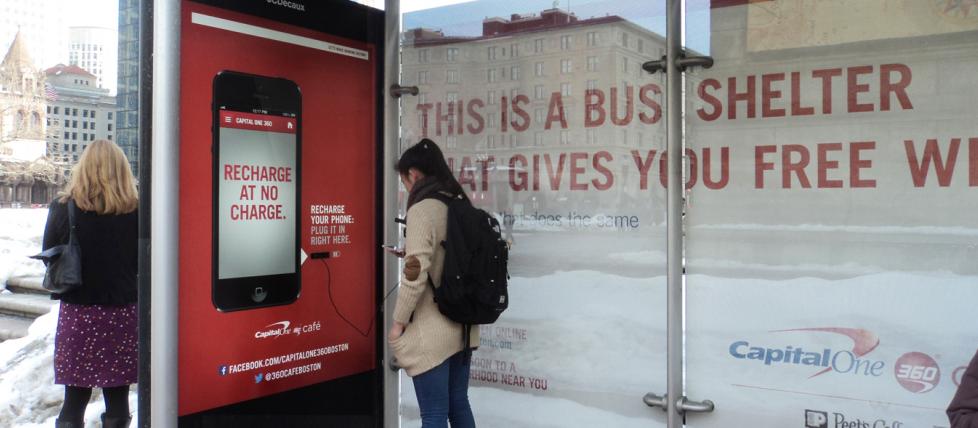
Out of Home advertising revenue hit an all-time high of $7.6 billion in 2016. Combined with advances in audience measurement and an industry updated value proposition, there is a lot to celebrate across America’s thriving Out of Home market.
Digital transformation is helping to drive growth and modernisation whilst expanding the medium’s communication potential. Technological advances such as facial recognition, dynamic content triggers, and augmented reality, are all helping to increase the creative storytelling power of OOH.
However, alongside positive financial growth and technological innovation, there has been a growing climate of creative discontent. Recognition that creativity has not kept pace with technological change, and that the medium could be playing a much bigger role in the Digital Age.
Dawn Hudson, NFL’s CMO, and major digital OOH spender, highlighted this dichotomy when talking about the challenges in bringing new ideas to life, at the OAAA’s National Convention in New Orleans. Hudson surmised that what really matters to marketers is connectivity, between mediums and consumers, for building targeted and tailored communication. To make this happen better use of data and technology are essential.
Ubiquitous smartphone ownership and wifi penetration in cities around the world are contributing to the significant pool of data available to inform outdoor creative. Surprising then, that smart, data driven campaigns are still the exception rather than the rule for digital OOH. One of the major challenges for improving creativity is the diversity of the digital OOH media landscape and the lack of standardization.
Fast, siloed growth, driven by separate media owners, across a range of urban spaces, has resulted in a myriad of formats, shapes, sizes, durations and file specifications to create for. This makes delivering creative for large scale campaigns across multiple networks and markets difficult. So, how do we move the medium on from a static branding channel, to timely, contextual, and programmatically informed conduit? And, how can we remain effective as an industry where global rollouts are becoming the new standard?
This is an area of focus for the entire industry with the OAAA working alongside the DPAA, IAB, DSF to simplify creative automation through the amalgamation of industry specifications. The report, “Programmatic Standards for Digital Out-of-Home (DOOH)” suggests a goal would be for publishers to utilize the same standards so that one buyer’s creative can be placed against numerous companies.
In the meantime, there are third-party ad serving platforms in place to enable advertisers to centrally control and publish dynamic, scalable creative to multiple digital OOH networks. Providing ease of use and creative fulfillment as the medium looks to exploit new programmatic efficiencies.
There are some promising signs that the medium is heading in the right direction. Google Play Music launched a multi-market execution that replicated the music app’s ability to suggest the perfect soundtrack based on consumer mindset, location, time of day, and other factors such as traffic, weather, and real-world events. KY’s “Making OOH Last Longer” campaign, also provided targeted and contextual messaging based on location, time of day, traffic data, and national events.
Digital technology is opening up new avenues for creativity. As digital OOH formats, environments and markets expand, global rollout starts to become the new standard. Just like other digital mediums, OOH requires the infrastructure, strategies, systemized workflow and creative toolkits to face the challenges.
Yes, the industry is experiencing some growing pains but these challenges are a good signifier of just how far the industry has come. So let’s use our feelings of creative discontent to elevate the medium. To reject the status quo and embrace an attitude of perpetual learning and growth. OOH should be playing a much bigger role in the Digital Age.
About Ben Putland, MD of QDOT, & COO of Grand Visual U.S.
Ben Putland is the managing director of QDOT, the first independent ad tech business delivering smarter campaign management for digital OOH. Based in New York, Ben oversees software development and manages account teams in the UK, U.S., and LATAM. Ben also continues his role as COO of Grand Visual New York handling their business in the US where he has delivered many award-winning DOOH campaigns for clients such as Google, Amazon, Pepsi, Disney, and Microsoft. Prior to Grand Visual, Ben accrued more than 10 years’ experience delivering digital media innovation and has built and led project teams in the UK, Holland, and Japan, for the likes of Proximity, Wieden+Kennedy and Dentsu. Ben is an active member of the OAAA’s Innovation Lab, a regular speaker at SXSW, DSE and the ICX Summit and a contributor to ExchangeWire.
Download the PDF
Published: August 22, 2017